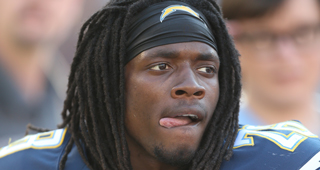With reliable, starting caliber running backs emerging from the later rounds of the draft and their relatively short careers, selecting even elite talents at the position in the first round has become a proposition teams have begun to avoid.
There have been 24 running backs taken in the first round of the NFL draft over the past 10 years. In the last two drafts alone, Melvin Gordon, Todd Gurley, and Ezekiel Elliott were selected in the first round.
Gurley began to prove himself last season with 1,106 yards on 229 carries and 10 touchdowns. Gordon didn’t have the same type of success with the Chargers, rushing for just 641 yards and zero touchdowns on 184 carries.
The selection of Gordon with the 15th overall pick continued the Chargers’ history of first round running backs following Ryan Mathews with the 12th overall pick in 2010 and LaDainian Tomlinson with the fifth overall pick in the 2001 draft. Mathews’ career in San Diego was plagued by injury, while Tomlinson became a franchise player and future Hall of Famer for the Chargers.
In his final season at Wisconsin, Gordon rushed for 2,587 yards on 343 carries and 29 touchdowns. He also averaged an outstanding 7.5 yards per carry.
On November 15, 2015, Gordon broke Tomlinson’s single-game rushing record (406) against the Nebraska Cornhuskers. In that game, Gordon put the team on his back rushing for 408 yards on 25 carries and four scores, leading the Badgers to a 59-22 victory.
In the snow, Gordon showed why he was second in the Heisman voting and a consensus All-American. He showed the vision to find the opening lane and the ability to bounce multiple runs to the outside for a huge gain. He also showed his underrated speed, which he isn’t known for and as Nebraska found out if you do not contain the outside, he will hurt you all day long.
It was an utter masterpiece that Gordon put together that day and was one of the most memorable moments in his college career that he would take with him getting prepared for the 2015 NFL Draft. At the NFL combine, Gordon ran a 4.52 40-yard dash, which is solid for a 6-foot-1, 207-pound running back because he isn’t a speedster. According to his draft profile on NFL.com, Lance Zierlein pointed out that while Gordon is a talented open-field runner, he is not trustworthy enough to be a three-down back.
Fast forward to Gordon’s rookie season and one of his problems was finding the open lane, to display his talents. While that problem was partly his fault, San Diego’s offensive line was at fault too.
According to Football Outsiders’ run blocking stats, the Chargers’ offensive line was ranked 31st in adjusted line yards (3.18), 15th in stuffed (20%), 32nd in second level yards (0.85) and 27th in open field yards (0.53).
To sum up those numbers, it means San Diego’s offensive line was not getting any push, hence why Gordon and the other running backs struggled. Another reason why Gordon struggled last season was because of injury. Late in the season, Gordon suffered a knee injury against the Miami Dolphins that caused damage to his cartilage, ending his rookie season.
But what about this upcoming season? Can Gordon shake off his rookie woes and turn in a great sophomore campaign?
For starters, Gordon is now healthy as he underwent microfracture surgery in January to repair the cartilage in his left knee. This summer, Gordon came into training camp confident and Philip Rivers noticed saying that the second-year running back looked comfortable.
What will also make the Gordon more comfortable this season is that the Chargers upgraded the offensive line. This offseason, San Diego signed veteran Matt Slauson who brings leadership, professionalism, and hastiness. Gordon has already noticed the impact of Slauson by simply saying he has those guys working.
That bodes well for Gordon as he got off to a great start last week in San Diego’s preseason opener against the Tennessee Titans. In his first since December, Gordon had 12 rushing yards on three carries but showed a burst of speed on a dump off pass by Rivers that he took 44 yards to the end zone.
The catch and run afterwards was the Gordon that we saw at Wisconsin, who terrorized Big Ten defenses by making them pay once he got some space. If the Chargers’ offensive line can stay healthy along with Gordon just playing with confidence and letting the game come to him, he could breakout with over 1,000 yards rushing.



